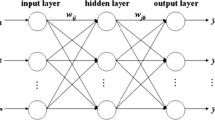Abstract
A constrained optimization method based on back-propagation (BP) neural network is proposed in this paper. Taking the maximization of output for example, using unipolar sigmoid function as transfer function, the method presents a general mathematical expression of BP neural network constrained optimization and derives the partial derivative of output with respect to input. On this basis, the fundamental idea, algorithms and related models are given in this article. When BP neural network is on the basis of fitting, this method can adjust the input values of BP neural network to make the output values maximal or minimal. Therefore, with this method the application of BP neural network is expanded by combining BP network’s fitting with optimization. At the same time, the article also provides a new method to study the black-box problem. The experiments show that the constrained optimization method is effective.

Similar content being viewed by others
References
Zeng L, Liu J, Qin Y, Wang ZY (2014) The shift system of automated mechanical transmission based on neural network control. In: Proceeding of the 11th world congress on intelligent control and automation. doi:10.1109/WCICA.2014.7053397
Shahar Yuval, Goren-Bar Dina, Boaz David, Tahan Gil (2006) Distributed, intelligent, interactive visualization and exploration of time-oriented clinical data and their abstractions. Artif Intell Med 38(2):115–135. doi:10.1016/j.artmed.2005.03.001
Mahdipour E, Dadkhah C (2014) Automatic fire detection based on soft computing techniques: review from 2000 to 2010. Artif Intell Rev 42(4):1–40. doi:10.1007/s10462-012-9345-z
Mirsepahi A, Chen L, O’Neill B (2014) A comparative approach of inverse modeling applied to an irradiative batch dryer employing several artificial neural networks. Int Commun Heat Mass Transf 53:164–174. doi:10.1016/j.icheatmasstransfer.2014.02.028
Takefuji Y (1992) Neural network parallel computing. Springer, Heidelberg. doi:10.1007/978-1-4615-3642-0
Bolnokin VE, Mutin DI, Tuan NA, Povalyaev AD (2015) Models of adaptive control system design for nonlinear dynamic plants based on a neural network. Autom Remote Control 76(3):493–499. doi:10.1134/S0005117915030133
Zhang Z, Ma X, Yang Y (2003) Bounds on the number of hidden neurons in three-layer binary neural networks. Neural Netw 16(7):995–1002. doi:10.1016/S0893-6080(03)00006-6
Liang X, Chen RC (2010) A unified mathematical form for removing neurons based on orthogonal projection and crosswise propagation. Neural Comput Appl 19(3):445–457. doi:10.1007/s00521-009-0321-8
Funahashi K-I (1989) On the approximate realization of continuous mappings by neural networks. Neural Netw 2(3):183–192. doi:10.1016/0893-6080(89)90003-8
Chua CG, Goh ATC (2003) A hybrid Bayesian back-propagation neural network approach to multivariate modeling. Int J Numer Anal Methods Geomech 27(8):651–667. doi:10.1002/nag.291
Zhang Y, Wu L (2008) Weights optimization of neural network via improved BCO approach. Prog Electromagn Res 83:185–198. doi:10.2528/PIER08051403
Jia WK, Zhao D, Shen T, Ding SF, Zhao YY, Hu CL (2015) An optimized classification algorithm by BP neural network based on PLS and HCA. Appl Intell 43(1):176–191. doi:10.1007/s10489-014-0618-x
Ding SF, Su CY, Yu JZ (2011) An optimizing BP neural network algorithm based on genetic algorithm. Artif Intell Rev 36(2):153–162. doi:10.1007/s10462-011-9208-z
Xu YJ, Zhang QW, Zhang WH, Zhang P (2015) Optimization of injection molding process parameters to improve the mechanical performance of polymer product against impact. Int J Adv Maunf Technol 76(9–12):2199–2208. doi:10.1007/s00170-014-6434-y
Cao CW, Zhang YK, Yu T, Gu XS, Xin Z, Li J (2015) A novel 3-layer mixed cultural evolutionary optimization framework for optimal operation of syngas production in a Texaco coal-water slurry gasifier. Chin J Chem Eng 23(9):1484–1501. doi:10.1016/j.cjche.2015.03.005
Zhai SJ, Jiang T (2015) A new sense-through-foliage target recognition method based on hybrid differential evolution and self-adaptive particle swarm optimization-based support vector machine. 149:573–584. doi:10.1016/j.neucom.2014.08.017
Yan S, Lang M (2013) Optimization for railway freight transport network based on BP neural network. In: IEEE international conference on mechatronic sciences electric engineering and computer, vol 1037, pp 404–410. doi:10.1109/MEC.2013.6885411
Han XH, Xiong XY, Duan F (2015) A new method for image segmentation based on BP neural network and gravitational search algorithm enhanced by cat chaotic mapping. Appl Intell 43(4):855–873. doi:10.1007/s10489-015-0679-5
Liu YP, Wu MG, Qian JX (2007) Predicting coal ash fusion temperature based on its chemical composition using ACO-BP neural network. Thermochim Acta 454(1):64–68. doi:10.1016/j.tca.2006.10.026
Wang FL, Liu GL, Wang JQ (2010) An unconstrainted optimization method based on BP neural network. ICIC Exp Lett 7(11):1–4. doi:10.1109/ICEEE.2010.5660683
Basheer IA, Hajmeer M (2001) Artificial neural networks: fundamentals, computing, design, and application. J Microbiol Methods 43(1):3–31. doi:10.1016/S0167-7012(00)00201-3
Zhang ML, Zhou ZH (2006) Multilabel neural networks with applications to functional genomics and text categorization. IEEE Trans Knowl Data Eng 18(10):1338–1351
Zhang L, Luo JH, Yang SY (2009) Forecasting box office revenue of movies with BP neural network. Expert Syst Appl 36(3):6580–6587. doi:10.1016/j.eswa.2008.07.064
Galushkin AI (2007) Design of neural network optimal models. Springer, Berlin. doi:10.1007/978-3-540-48125-6_7
Fine TL (1999) Feedforward neural network methodology. Springer, New York. doi:10.1007/b97705
De Wilde P (1997) Neural network models. Springer, London. doi:10.1007/978-1-84628-614-8
Acknowledgments
This research is supported by National Social Science Foundation of China (Nos: 13BJY098), Project in the National Science & Technology Pillar Program during the Twelfth Five-year Plan Period of China (Nos: 2014BAD06B04-2-9) and Agriculture Industry Research Special Funds for Public Welfare Projects of China.
Author information
Authors and Affiliations
Corresponding author
Ethics declarations
Conflict of interest
The author declares that they have no conflict of interest.
Rights and permissions
About this article
Cite this article
Zhang, L., Wang, F., Sun, T. et al. A constrained optimization method based on BP neural network. Neural Comput & Applic 29, 413–421 (2018). https://doi.org/10.1007/s00521-016-2455-9
Received:
Accepted:
Published:
Issue Date:
DOI: https://doi.org/10.1007/s00521-016-2455-9




